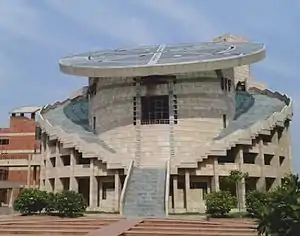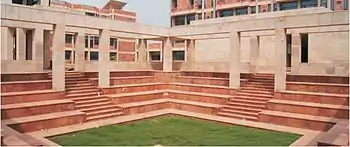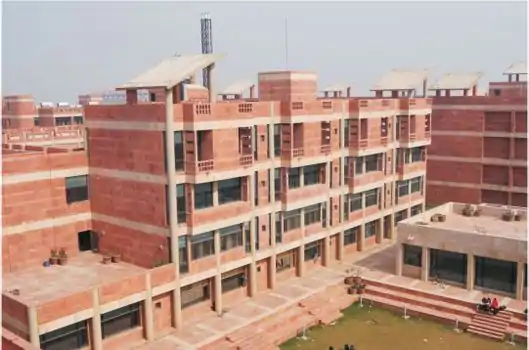State Institute of Urban Planning and Architecture
State Institute of Urban Planning and Architecture has been established in the year 2012 to provide quality education in the field of Architecture and Urban Planning. It is located in Rohtak, Haryana and is under the direct supervision of GTIS.[1]
| Type | Government |
|---|---|
| Established | 2012 |
| Location | , , |
| Campus | Urban |
| Affiliations | State University Of Performing and Visual Arts . |
| Website |
The Campus
The campus comprises four institutes namely State Institute of Design (SID), State Institute of Film and Television (SIFTV), State Institute of Fine Arts (SIFA) and State Institute of Urban Planning and Architecture (SIUPA). These institutes are modelled on the lines of respective apex institutes of national importance. The Campus is being established at a capital expenditure of Rs. 300 crore by the Government of Haryana through Government Technical Institution Society, Rohtak. Each of the four individual institutes is provided with separate institute building and common central facilities including an auditorium, art gallery, knowledge centre and a cafeteria. The campus is designed by internationally renowned architect Raj Rewal and M/s RITES (A Government of India Enterprise) is the project management consultant.[2]
Admission Process
10+2 examination passed or appearing under recognised Central/State Board of Secondary Education/Council for Indian School of Certificate Examination, New Delhi with English & Math as compulsory subjects. As per COA norms, the minimum 10+2 aggregate percentage should be 50% or more. Or 3 years diploma recognised by AICTE or State Board of Technical Education (minimum 50% marks) with valid NATA score.

Students achievements
Student Activities and Achievements in NASA Students of Architecture are members of NASA, the National Association of Students of Architecture. Through these activities, the students get opportunities to interact with their contemporaries from all over the country and to view work approaches in other architecture institutions for mutual benefit and learning. Students of SIUPA have participated in Annual NASA and Zonal NASA events since the inception of the institute in 2012. The students have won prizes in several events organized by NASA:
Study tour
Study tour of SIUPA students to Ahmedabad was conducted in the year 2012. The Students during the tour visited Sabarmati Ashram, Hussain Doshi Gufa, Bhadra Fort, Teen Darwaza, Akshardham Temple, Hathee Singh Temple, Jama Masjid, Indian Institute of Management and National Institute of Design. Study tour of SIUPA students to Chandigarh was conducted in the year 2013 to enlighten them with Architectural and Planning aspects of the India's first planned city. [3]
The Faculty
- Ar. Ajay Kaushik(HOD)
 An Open Hall of SIUPA
An Open Hall of SIUPA - Ar. Ajaybahu Joshi
- Ar. Pardeep Kumar
- Ar. Supri Maheshwari
- Ar. Shalini Sheoran
- Ar. Vijaya Prakash Singh
- Ar. Pradeep Kumar Attri
- Er. Vikas
- Ar. Himanshu Phogat
- Ar. Sahil Pahal
- Planner Vaishali
- Ar. Meet Fayewar
- Ar. Shruti Gautam
- Ar. Deepika Sangroha
- Ar. Nidhi Malik
Members of Academic Council
- Ar. Raj Rewal
Chairman Delhi Urban Arts Commission
- Ar. B. K. Sengupta
Professor, Indian Institute of Technology, Kharagpur
- Ar. Alok Ranjan
 Architecture Block of SIUPA,Rohtak
Architecture Block of SIUPA,Rohtak
Professor, Malaviya National Institute of Technology, Jaipur
- Ar. Debashis Sanyal
National Institute of Technology, Raipur
- Ar. Rajneesh Vats
Former Principal,Chandigarh College of Architecture
- Ar. Rajeev Mishra
Principal,Sir J.J. College of Architecture, Mumbai
- Dr. Surinder Suneja
Professor,School of Planning & Architecture New Delhi
- Dr. GeetamTeewari
Professor,Indian Institute of Technology Delhi
- Dr. Manoj Arora
Professor,Indian Institute of Technology Roorkee
- Dr. T. Srinivas
National Institute of Technology, Trichi
- Prof. Utpal Sharma
Centre of Environmental Planning & Technology University, Ahmedabad
See also
- State Institute of Film and Television
- State Institute of Fine Arts
- State Institute of Design
References
- "About SPA". spa.ac.in. Retrieved 3 January 2012.
- In Which Annie Gives It Those Ones (1989) Archived 23 February 2014 at the Wayback Machine anupamachopra.com.Originally published in the Mumbai Mirror. Retrieved 16 November 2012
- {http://www.spa.ac.in/courses.aspx}
- https://plcsupva.ac.in/facultyupa/
- List of Deemed universities, as of 2008 University Grants Commission